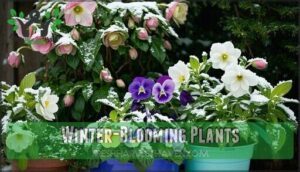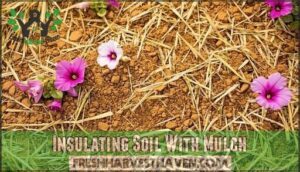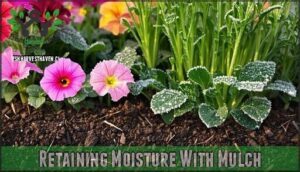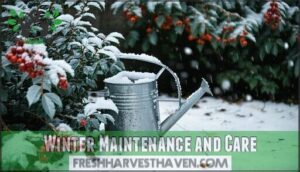This site is supported by our readers. We may earn a commission, at no cost to you, if you purchase through links.

Water less frequently since plants need reduced moisture, but don’t let them completely dry out.
Protect tender blooms with row covers or cold frames when temperatures drop.
Choose cold-hardy varieties like pansies, snapdragons, and winter jasmine that actually thrive in cooler weather.
Apply a thick layer of mulch around plant bases to insulate roots and retain soil moisture.
Move container plants to sheltered spots or wrap pots with bubble wrap.
Monitor for common winter pests like aphids that seek warm hiding spots.
Smart winter flower garden care means working with nature’s rhythm rather than against it, using techniques like mulch and row covers to protect plants, and selecting varieties that are cold-hardy to ensure a thriving garden.
Table Of Contents
- Key Takeaways
- Winter Garden Preparation
- Selecting Winter Flowers
- Mulching and Soil Care
- Protecting Perennials and Roses
- Winter Maintenance and Care
- Frequently Asked Questions (FAQs)
- How do I prepare my flower garden for winter?
- Do you cut back flowers for winter?
- How to care for perennial flowers in winter?
- How often should you water winter flowers?
- What to do with flowers for winter?
- How often water winter flowers indoors?
- Can I grow flowers in winter greenhouse?
- What flowers attract winter birds and bees?
- How to propagate winter flowers from cuttings?
- Do winter flowers need extra humidity support?
- Conclusion
Key Takeaways
- Choose cold-hardy varieties like pansies, hellebores, and winter jasmine that’ll thrive when temperatures drop below freezing
- Apply 2-4 inches of mulch around plant bases to insulate roots and prevent soil temperature swings throughout winter
- Protect tender plants with frost cloth, row covers, or by moving containers to sheltered spots when frost threatens
- Water sparingly but consistently – check soil moisture daily and only water when the top inch feels dry to prevent root rot
Winter Garden Preparation
Getting your garden ready for winter doesn’t have to feel overwhelming.
You’ll want to harvest tender vegetables before frost hits, store root crops properly, and give your plants the protection they need to survive the cold months ahead, including providing them with the necessary care to make it through the winter.
Harvesting Tender Vegetables
Before the first frost hits, you’ll want to harvest all your tender vegetables like tomatoes, zucchini, peas, beans, and winter squash.
These cold-sensitive crops can’t survive freezing temperatures, so timing is everything. Check ripeness carefully – green tomatoes can ripen indoors if needed.
Handle harvested vegetables gently to maintain quality, and clean off any soil before storing. To guarantee longevity, consider optimal storage environments for your harvested goods.
This differs from hardy vegetables like kale and Brussels sprouts, which actually improve after frost exposure.
Storing Root Crops
Root crops like potatoes, carrots, and beets need dark, cool storage with proper humidity levels for winter preservation.
Perfect storage means dark, cool conditions with controlled humidity—your root vegetables’ ticket to lasting freshness all winter long.
Choose ventilated storage containers that allow air circulation while preventing rot.
Maintain temperatures between 32-40°F with 85-95% humidity.
Consider specialized storage solutions for ideal preservation.
Check stored vegetables regularly, removing any showing signs of decay to protect the rest of your winter harvest.
Protecting Plants From Frost
When winter’s chill threatens your garden, frost protection becomes your plants’ lifeline.
Drape frost cloth over delicate blooms, providing breathable coverage that traps warm air while allowing moisture to escape.
Wrap tender perennials in burlap for added insulation against harsh winds.
Install raised bed tunnels or position cloches over individual plants to create protective microclimates.
Consider using specialized plant covers for enhanced protection.
Group containers together near sheltered walls where they’ll benefit from shared warmth and wind protection.
These winter plant protection strategies guarantee your cold weather gardening efforts pay off with thriving blooms.
Selecting Winter Flowers
You’ll discover that winter doesn’t mean saying goodbye to garden color when you choose the right flowers.
Cold-tolerant varieties and strategic planning can keep your outdoor spaces vibrant even when temperatures drop.
Cold-Tolerant Flower Varieties
Now that you’ve got your garden prepped, let’s talk about the stars of your winter show.
These cold-tolerant flower varieties thrive when temperatures drop:
- Pansies – Hardy to -10°C with cheerful faces
- Hellebores – Survive -15°C in shaded spots
- Snowdrops – Withstand brutal -20°C temperatures
- Violas – Bloom through -10°C frosts
- Winter aconite – Early golden winter blooms
Choose hardy flower types based on your Hardiness Zones for reliable winter blooms and stunning flower color.
Some gardeners even choose to plant winter blooming bulbs for added variety.
Climate Considerations
Understanding your garden’s climate helps you pick flowers that’ll actually survive winter’s bite. Hardiness Zones guide plant selection, but microclimates create pockets where tender plants thrive.
Regional variations mean your neighbor’s success mightn’t translate to your yard.
| Climate Factor | Impact on Winter Flowers |
|---|---|
| Frost Dates | Determines planting and protection timing |
| Snow Cover | Insulates roots, protects from temperature swings |
| Wind Exposure | Causes desiccation, increases cold damage |
| Microclimates | Creates warmer spots near walls, structures |
| Zone Hardiness | Sets baseline for plant survival temperatures |
Smart selecting winter flowers means matching plants to your specific conditions, not just your zone.
Winter-Blooming Plants
Anyone can transform their winter landscape with strategic winter blooming plants that laugh in the face of cold weather.
These hardy performers bring unexpected winter flower garden care rewards through tough seasons.
Choose from these cold weather gardening champions:
- Indoor Blooms like amaryllis for reliable garden color
- Fragrant Plants such as witch hazel for aromatic winter appeal
- Hardy varieties including pansies and hellebores for lasting beauty
- Strategic timing with bulbs planted for spring emergence
Consider microclimates and planting timing for ideal winter flower varieties success.
Mulching and Soil Care
Proper mulching acts as winter’s best insurance policy for your flower garden, protecting soil from temperature swings while locking in essential moisture.
You’ll want to apply 2-4 inches of organic material like straw or shredded leaves to create a protective barrier that prevents erosion and keeps your plants’ roots cozy through the coldest months, which is a key part of winter’s best insurance policy.
Insulating Soil With Mulch
Mulch Materials act like nature’s thermostat for your winter flower garden.
Apply 2-4 inches of straw or shredded leaves around your plants to create steady Temperature Regulation that prevents soil from freezing and thawing repeatedly.
This insulating soil with mulch technique keeps roots cozy while providing excellent Weed Suppression throughout the cold months.
Winter garden mulching isn’t just about protection—it’s about creating the perfect environment for Soil Health.
Choose your mulch wisely: straw works beautifully for roses, while shredded leaves break down slowly to feed the soil.
Consider buying straw mulch for effective insulation.
The right winter garden soil care approach means your flowers won’t stress from temperature swings, and you’ll spend less time battling weeds come spring.
Think of it as tucking your garden in for a long winter’s nap.
Retaining Moisture With Mulch
Your winter flower garden stays healthier when you maintain consistent soil moisture through smart mulching techniques.
Apply 2-4 inches of organic mulch types like shredded leaves or straw around plants.
This application depth creates a moisture-trapping barrier that reduces evaporation by up to 50%.
Beyond moisture benefits, proper mulching provides temperature regulation and weed suppression, keeping your blooms thriving.
Preventing Soil Erosion
Beyond moisture retention, your garden soil faces winter’s relentless assault through erosion. Cover crop benefits shine here—plant winter rye or clover for natural erosion control.
Apply mulch application techniques with 2-inch layers, avoiding wet soil to prevent compaction. Consider these protective strategies:
- Install erosion control fabrics on slopes
- Create terracing garden beds for steep areas
- Plant windbreak planting barriers around exposed beds
To further enrich the soil, consider how organic matter transforms clay soil. Proper winter garden soil preparation transforms vulnerable earth into fortress-strong ground.
Protecting Perennials and Roses
Your perennials and roses need targeted winter protection to survive harsh weather and bloom beautifully next season.
The right combination of pruning, mulching, and special care techniques will keep these garden favorites healthy through freezing temperatures.
Cutting Back Perennials
Cutting back perennials starts with selecting proper pruning tools. Focus on deadheading spent blooms while leaving seedhead aesthetics intact for wildlife considerations.
This dormancy preparation supports healthy spring growth. Skip evergreen varieties entirely—they don’t need winter flower garden care trimming.
Your perennial care routine of cutting back perennials creates deadheading benefits while maintaining winter garden perennial care standards.
Mulching Roses
Timing your rose winter protection just after the first frost sets the stage for success. Apply 2-3 inches of mulch around the base using straw, leaves, or compost—these mulch types work best for rose care.
Different rose varieties handle regional climate variations differently, but all benefit from consistent application timing. Proper mulching roses creates essential winter garden rose care that truly protects plants from frost damage throughout harsh months.
Roses also benefit from preventative measures against fungal diseases; consider ensuring good airflow around your plants.
Winter Care for Tender Perennials
Tender perennials need special attention to survive harsh winters. Indoor overwintering protects these delicate plants from freezing temperatures and frost damage.
Essential winter care for tender perennials includes:
- Gradual acclimation when moving plants indoors
- Container protection using mulch around pots
- Pest prevention through regular inspection
- Dormancy strategies like reducing water and fertilizer
These winter garden protection methods guarantee your tender perennials return stronger next spring.
Winter Maintenance and Care
Winter’s harsh conditions don’t mean you’ll lose your beautiful flowers if you stay on top of basic care tasks.
With the right watering schedule, regular pruning, and pest monitoring, you’ll keep your winter blooms healthy and vibrant all season long.
You’ll be able to enjoy your winter blooms throughout the season with proper care.
Watering and Fertilizing
Winter watering requires careful balance—you’ll check soil moisture daily, watering only when dry.
Winter watering needs a delicate touch—check daily, water only when soil feels dry to your fingertips.
Indoor humidity matters for houseplants, while outdoor plants need deep watering before frost.
Dormancy fertilizing supports spring growth, but avoid over-fertilization which weakens plants.
Your winter flower garden care succeeds through mindful winter garden hydration and strategic winter garden fertilizing timing.
Pruning and Deadheading
Proper pruning and deadheading keep your winter blooms healthy and attractive throughout the cold months.
Sharp, clean tools prevent disease spread while encouraging continued flowering.
- Remove spent blooms weekly – Cut just above the next flower bud or leaf node
- Prune damaged branches immediately – Make clean cuts at 45-degree angles to promote healing
- Shape shrubs lightly – Focus on maintaining form rather than heavy cutting during dormancy
Monitoring for Pests and Diseases
Everyone knows winter brings unique challenges, but spotting problems early makes all the difference.
Early detection through weekly pest inspection can prevent 70% of winter garden diseases from spreading. Watch for indoor pests like aphids and spider mites, plus dormant pests hiding in mulch.
Fungal control becomes critical in humid conditions—powdery mildew affects 30% of winter flowers. Preventative measures like proper air circulation and avoiding overhead watering reduce winter garden pests substantially.
Frequently Asked Questions (FAQs)
How do I prepare my flower garden for winter?
Like autumn leaves surrendering to winter’s embrace, you’ll gently guide your flowers through their seasonal slumber.
Cut back dead perennials, mulch around plant bases with 2-3 inches of organic material, and protect tender plants with frost cloth or by bringing them indoors.
Do you cut back flowers for winter?
Yes, you should cut back most perennials after the first frost to remove dead material and promote healthy spring growth.
However, leave seed heads for wildlife and avoid cutting evergreens unless necessary.
How to care for perennial flowers in winter?
Think of perennials as sleeping beauties tucked under winter’s blanket.
Cut back dead foliage after frost, then add 2-4 inches of mulch around the base for root insulation and temperature regulation.
How often should you water winter flowers?
Water winter flowers sparingly, checking soil moisture daily. Only water when the top inch feels dry to your touch. Overwatering kills more winter blooms than underwatering does.
What to do with flowers for winter?
Consider Sarah’s garden: she cut back her perennials but left ornamental grasses standing.
You’ll want to cut back dead perennials, mulch tender plants, bring containers indoors, and use frost protection like row covers for delicate blooms.
How often water winter flowers indoors?
Check your indoor winter flowers‘ soil moisture daily by sticking your finger about an inch deep.
Water only when the top layer feels dry, typically every 3-5 days, depending on humidity and temperature conditions.
Can I grow flowers in winter greenhouse?
Despite winter’s chill limiting outdoor options, you can absolutely grow flowers in a greenhouse! It protects tender plants, extends growing seasons, and maintains ideal temperatures for beautiful blooms year-round.
What flowers attract winter birds and bees?
Winter-blooming hellebores, witch hazel, and mahonia attract bees during mild spells. Berry-producing plants like winterberry holly, sumac, and crabapples provide food for birds throughout cold months.
How to propagate winter flowers from cuttings?
Take softwood cuttings from healthy winter-blooming plants like hellebores or winter jasmine.
Cut 4-6 inch stems, dip in rooting hormone, plant in well-draining potting mix.
Keep consistently moist in bright, indirect light.
Do winter flowers need extra humidity support?
Like plants thirsting in desert air, your winter blooms need extra humidity.
They are stressed by indoor heating that creates dry conditions.
Use humidifier, humidity trays, group plants together, or run a humidifier to maintain 40-60% humidity levels for healthier winter flowering.
Conclusion
Don’t think winter means abandoning your flower garden entirely – with proper winter flower garden care, you’ll enjoy blooms even during frost season.
Your garden doesn’t have to look barren when temperatures drop. By implementing these protective strategies, selecting appropriate varieties, and maintaining consistent care routines, you’ll successfully nurture flowers through winter’s challenges.
Remember, cold-hardy plants combined with smart protection methods create stunning displays year-round. Your winter garden can thrive with dedication and proper care, enjoying blooms even in the harshest of seasons.
- https://www.borstlandscape.com/articles/winter-garden-maintenance-tips/
- https://www.grossiflorist.com/post/how-to-keep-your-flowers-blooming-in-cold-weather-10-essential-tips
- https://brambleandbeyond.com/sustainable-winter-garden-care/
- https://terraplantsandflowers.ca/blogs/blog/how-to-take-care-of-flowers-winter
- https://planetdetroit.org/2024/03/warmer-winter-affects-plants/











